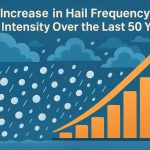Hailstorms can occur suddenly and cause serious damage and injuries if proper safety measures are not taken. Hailstones—balls of solid ice—can fall at high speeds, especially during severe thunderstorms. Knowing how to stay safe during a hailstorm can protect lives, property, and prevent injuries.
Why Is Hail Dangerous?
Hailstones may vary in size from small peas to softballs. Larger hail can:
- Break windows and windshields
- Dent vehicles and roofs
- Injure people and animals caught outside
- Damage crops, power lines, and infrastructure
Even small hail at high velocity can be painful or dangerous when hitting the body, especially the head and eyes.
What to Do if You’re Indoors
If you are inside when a hailstorm starts:
- Stay away from windows, skylights, and glass doors to avoid being hurt by shattered glass
- Close curtains or blinds to reduce glass scatter if a window breaks
- Remain indoors until the storm passes, even if the hail seems small
- Monitor the weather using radio, TV, or emergency apps
Basements or interior rooms are safest during very strong hailstorms combined with wind or lightning.
If You’re Outside or Driving
Caught outdoors? Take these steps:
- Seek shelter immediately in a sturdy building or covered structure
- Avoid trees—they may attract lightning
- If shelter isn’t available, protect your head and lie down in a low area away from flood risk
- If driving, pull over under a bridge or gas station canopy if safe
- Stay in your car with the engine off and face away from windows
- Cover your face and head with your arms or a blanket if possible
Never try to outrun a hailstorm—hail often falls ahead of fast-moving storm clouds.
After the Storm
Once the hailstorm ends:
- Check for injuries and seek medical attention if needed
- Stay clear of downed power lines or broken glass
- Inspect your home or car for damage and take photos for insurance claims
- Report significant hail to weather authorities to help improve future warnings
If hail damaged your roof, check for leaks during the next rainfall or have it inspected by a professional.
Preparedness Tips
- Keep a first-aid kit, flashlight, and weather radio at home
- Know local emergency numbers
- Install impact-resistant roofing and windows in hail-prone regions
- Keep vehicles in garages or under carports when storms are forecast
- Teach children what to do during hailstorms as part of household safety plans
Glossary
- Hailstorm – a thunderstorm that produces falling ice stones
- Thunderstorm – a storm with lightning, thunder, rain, and possibly hail
- First-aid kit – a collection of supplies used for treating minor injuries
- Impact-resistant – built to withstand force without breaking
- Weather radio – a device that gives official emergency weather alerts
- Insurance claim – a request for payment after property damage or loss


